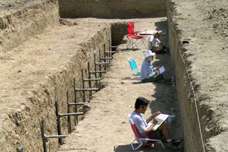Fault finding: UCI seismologist finds far more frequent earthquakes along the San Andreas

(PhysOrg.com) -- UCI seismologist Lisa Grant Ludwig finds far more frequent earthquakes along the San Andreas fault.
Lisa Grant Ludwig sees the world differently than most. Back from vacation near Lake Tahoe, the UC Irvine seismologist avidly shows off photos of a small, tree-covered ridge. To her, it’s the most perfectly formed ancient earthquake fault that she’s seen. But she wouldn’t let her family set foot in a nearby cantina made of unreinforced masonry.
“If an earthquake struck while we were in there, we’d end up seriously injured or dead,” she says.
Occupational hazard or life preserver, that ability to see what others don’t has motivated Ludwig for a quarter century. Now a hunch she had decades ago has upended previously held models of how often California’s mighty San Andreas fault ruptured in the past, and what it might do soon.
The findings in the Sept. 1 issue of Geology conclude that for the last 700 years, earthquakes have occurred far more often than once thought in the Carrizo Plain section, as often as every 45 to 144 years. The last big quake there was in 1857, more than 150 years ago.
“If you’re waiting for somebody to tell you when we’re close to the next San Andreas earthquake, just look at the data,” says Ludwig, principal investigator on the research.
Ludwig, a professor with UCI’s public health program, co-authored the paper with longtime assistant project scientist Sinan Akciz and Arizona State University geologists. Funding for the study was provided by the National Science Foundation, U.S. Geological Survey and Southern California Earthquake Center.
Earlier studies concluded major quakes occurred there every 250 to 400 years. But as a graduate student in the 1980s, Ludwig saw clues to a different timeline in the fault’s visible scars 120 miles north of Los Angeles. She collected tiny natural charcoal samples in the area, before carbon dating techniques were perfected. The charcoal forms naturally after wildfires, then is washed into the fault plain by rains, building up over the centuries in layers that are fragmented during earthquakes.
“I kept them in the garage, hoping the technology would improve,” she says.
It did. Even the smallest samples can now be dated via recently developed radiocarbon techniques. For the past decade, Ludwig, Akciz and others have dug trenches on the fault, collecting more and more samples, and putting together a radically different picture of activity there.
The field data confirmed what Ludwig had long suspected: Major earthquakes happened far more frequently than previous studies indicated - in some cases, perhaps just 45 years apart. Not all quakes were as strong as originally thought, either; but they all packed a wallop, ranging between magnitude 6.5 and 7.9.
Ken Hudnut, a geophysicist with the U.S. Geological Survey based in Southern California, says the research is significant.
“I believe they’ve done a really careful job,” he says, adding that the work was rigorously field-checked by many scientists. “When people come up with new results challenging old notions, others need to see the evidence for themselves.”
Ludwig cannot say for certain when an earthquake will strike. She is perturbed when a national television network exaggerates her findings. But she believes that it’s vital to get the word out. “I’m very worried. Every geologist who lives in Southern California and has seen the data is worried.”
Akciz, her assistant director, says of Ludwig, “All geologists see faults in ridges, but she takes it another step. She sees the potential for human harm.”
Ludwig hopes people here will be shaken out of their complacency, and buy more water, make emergency plans and tighten up building codes.
“People should not stick their heads in the ground,” she says. “That’s what this research does: It gives us a chance to prepare.”
Provided by UC Irvine
















